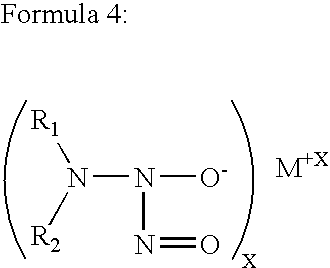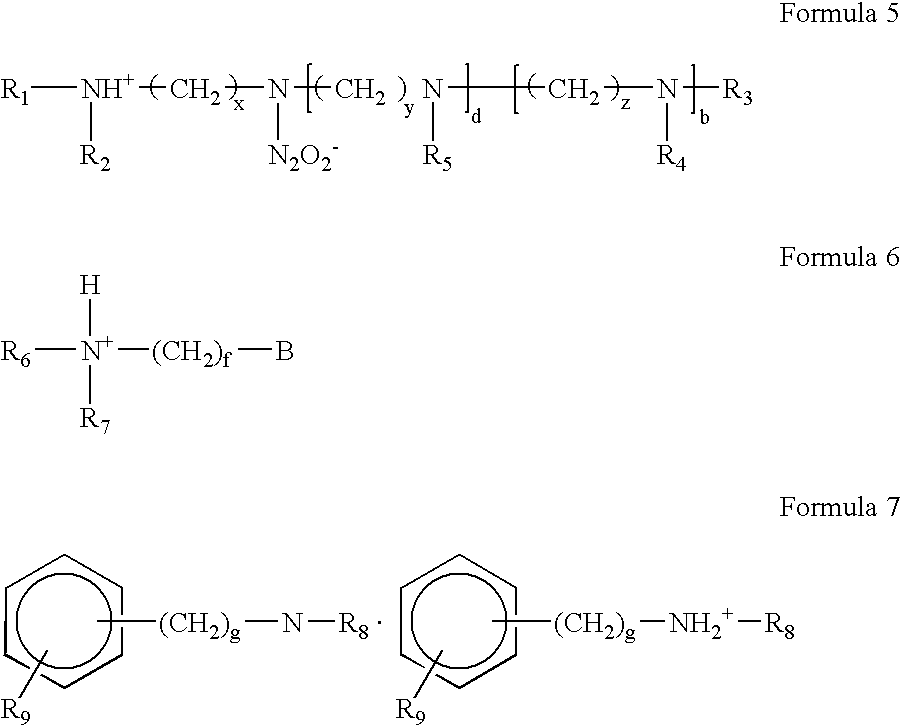Highly cross-linked, extremely hydrophobic nitric oxide-releasing polymers and methods for their manufacture and use
a nitric oxide and polymer technology, applied in the field of preparing nitric oxide releasing highly crosslinked, extremely hydrophobic polymers, can solve the problems of reducing the permeability restricting or occluding the injured vessel, and causing the rupture of the previously opened lumen. , to achieve the effect of preventing restenosis, preventing thrombosis and platelet activation, and high no loading capacity
- Summary
- Abstract
- Description
- Claims
- Application Information
AI Technical Summary
Benefits of technology
Problems solved by technology
Method used
Image
Examples
example 1
Polydiazeniumdiolation of Pentaethylene Hexamine-Derivatized Polydivinyl Benzene Micro-Beads using Acetonitrile (size: 5 μm, porosity: 100 Å)
[0065]In a 50 ml Parr® hydrogenation bottle was added 250 mg of pentaethylene hexamine-derivatized polydivinylbenzene micro-beads (size 5 μm, porosity: 100 Å) and 10 ml of acetonitrile. The bottle was attached to a NO apparatus and degassed by repeated cycles (×10) of pressurization / depressurization with N2 at 4 atmospheres. Next, the bottle was pressurized / depressurized with repeated cycles (×10) of NO at 4 atmospheres. The vessel was then filled with NO at 4 atmospheres and stirred at room temperature for 48 hrs. After 48 hrs. the bottle was purged of NO and pressurized / depressurized with repeated cycles (×10) of N2 at 4 atmospheres. The acetonitrile suspension of polydiazeniumdiolated pentaethylene hexamine-derivatized polydivinylbenzene micro-beads (size 5 μm, porosity: 100 Å) was then transferred to a 12 ml test tube and centrifuged in a D...
example 2
Diazeniumdiolation of Pentaethylene Hexamine-Derivatized Polydivinyl Benzene Micro-Beads using a 6% Sodium Methylate Solution (size: 5 μm, porosity: 100 Å)
[0067]In a 15 ml pear-shaped flask was added 300 mg of pentaethylene hexamine-derivatized polydivinylbenzene micro-beads (size 5 μm, porosity: 100 Å) and 10 ml of a 6% sodium methylate solution. The flask was placed in a Series 4751 Parr® pressure vessel and degassed by repeated cycles (×10) of pressurization / depressurization with N2 at 10 atmospheres. Next, the vessel was pressurized / depressurized with repeated cycles (×3) of NO at 30 atmospheres. The vessel was then filled with NO at 30 atmospheres and stirred at room temperature for 48 hrs. After 48 hrs, the vessel was purged of NO and pressurized / depressurized with repeated cycles (×10) of N2 at 10 atmospheres. The flask containing the polydiazeniumdiolated pentaethylene hexamine-derivatized polydivinylbenzene micro-beads (size 5 μm, porosity: 100 Å) was then removed from the ...
example 3
A Polymeric Blend Comprised of the Sodium Salt of Polydiazeniumdiolated Pentaethylene Hexamine-Derivatized Polydivinyl Benzene Micro-Beads (size: 5 μm, porosity: 100 Å) and Polyvinylchloride
[0069]In a KBr press was added 200 mg of polyvinyl chloride and 20 mg of the sodium salt of polydiazeniumdiolated pentaethylene hexamine-derivatized polydivinylbenzene (described in Example 2) and pressed using a hydraulic press to 12,000 psi. The resulting fragile pellet was placed on watch glass and cover with tetrahydrofuran. The solvent was allowed to slowly evaporate on the edge of a laboratory fume hood. The pellet which remained was briefly dried in vacuo and evaluated for its ability to release NO.
[0070]A sample consisting of approximately 25 percent of the pellet (0.51 mg) was immersed in phosphate buffer, pH 7.4 at 37° C., whereupon chemiluminescence-detectable NO evolved during a 14-day period of analysis. The total NO released was measured at 6.23×10−7 mole or 0.12 μmole / mg. By carefu...
PUM
| Property | Measurement | Unit |
|---|---|---|
| diameters | aaaaa | aaaaa |
| diameters | aaaaa | aaaaa |
| diameter | aaaaa | aaaaa |
Abstract
Description
Claims
Application Information
 Login to View More
Login to View More - R&D
- Intellectual Property
- Life Sciences
- Materials
- Tech Scout
- Unparalleled Data Quality
- Higher Quality Content
- 60% Fewer Hallucinations
Browse by: Latest US Patents, China's latest patents, Technical Efficacy Thesaurus, Application Domain, Technology Topic, Popular Technical Reports.
© 2025 PatSnap. All rights reserved.Legal|Privacy policy|Modern Slavery Act Transparency Statement|Sitemap|About US| Contact US: help@patsnap.com



